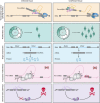The emerging significance of splicing in vertebrate development
- PMID: 36178052
- PMCID: PMC9641660
- DOI: 10.1242/dev.200373
The emerging significance of splicing in vertebrate development
Abstract
Splicing is a crucial regulatory node of gene expression that has been leveraged to expand the proteome from a limited number of genes. Indeed, the vast increase in intron number that accompanied vertebrate emergence might have aided the evolution of developmental and organismal complexity. Here, we review how animal models for core spliceosome components have provided insights into the role of splicing in vertebrate development, with a specific focus on neuronal, neural crest and skeletal development. To this end, we also discuss relevant spliceosomopathies, which are developmental disorders linked to mutations in spliceosome subunits. Finally, we discuss potential mechanisms that could underlie the tissue-specific phenotypes often observed upon spliceosome inhibition and identify gaps in our knowledge that, we hope, will inspire further research.
Keywords: Introns; Spliceosome; Spliceosomopathies; Splicing; Tissue-specific phenotypes; Vertebrate development.
© 2022. Published by The Company of Biologists Ltd.
Conflict of interest statement
Competing interests The authors declare no competing or financial interests.
Figures





Similar articles
-
Roles of minor spliceosome in intron recognition and the convergence with the better understood major spliceosome.Wiley Interdiscip Rev RNA. 2023 Jan;14(1):e1761. doi: 10.1002/wrna.1761. Epub 2022 Sep 2. Wiley Interdiscip Rev RNA. 2023. PMID: 36056453 Review.
-
Connecting genotype and phenotype in minor spliceosome diseases.RNA. 2025 Feb 19;31(3):284-299. doi: 10.1261/rna.080337.124. RNA. 2025. PMID: 39761998 Free PMC article. Review.
-
Minor intron splicing revisited: identification of new minor intron-containing genes and tissue-dependent retention and alternative splicing of minor introns.BMC Genomics. 2019 Aug 30;20(1):686. doi: 10.1186/s12864-019-6046-x. BMC Genomics. 2019. PMID: 31470809 Free PMC article.
-
Spliceosome twin introns in fungal nuclear transcripts.Fungal Genet Biol. 2013 Aug;57:48-57. doi: 10.1016/j.fgb.2013.06.003. Epub 2013 Jun 19. Fungal Genet Biol. 2013. PMID: 23792080
-
Disruption of exon-bridging interactions between the minor and major spliceosomes results in alternative splicing around minor introns.Nucleic Acids Res. 2021 Apr 6;49(6):3524-3545. doi: 10.1093/nar/gkab118. Nucleic Acids Res. 2021. PMID: 33660780 Free PMC article.
Cited by
-
Introns: the "dark matter" of the eukaryotic genome.Front Genet. 2023 May 16;14:1150212. doi: 10.3389/fgene.2023.1150212. eCollection 2023. Front Genet. 2023. PMID: 37260773 Free PMC article. Review.
-
Alternative splicing in stem cells and development: research progress and emerging technologies.Cell Regen. 2025 Jun 4;14(1):20. doi: 10.1186/s13619-025-00238-w. Cell Regen. 2025. PMID: 40465008 Free PMC article. Review.
-
Alternative splicing in shaping the molecular landscape of the cochlea.Front Cell Dev Biol. 2023 Mar 2;11:1143428. doi: 10.3389/fcell.2023.1143428. eCollection 2023. Front Cell Dev Biol. 2023. PMID: 36936679 Free PMC article. Review.
-
Circular RNAs regulate neuron size and migration of midbrain dopamine neurons during development.Nat Commun. 2024 Aug 8;15(1):6773. doi: 10.1038/s41467-024-51041-1. Nat Commun. 2024. PMID: 39117691 Free PMC article.
-
Taxonomy of introns and the evolution of minor introns.Nucleic Acids Res. 2024 Aug 27;52(15):9247-9266. doi: 10.1093/nar/gkae550. Nucleic Acids Res. 2024. PMID: 38943346 Free PMC article.
References
-
- Alam, S. S., Kumar, S., Beauchamp, M.-C., Bareke, E., Boucher, A., Nzirorera, N., Dong, Y., Padilla, R., Zhang, S. J., Majewski, J. et al. (2022). Snrpb is required in murine neural crest cells for proper splicing and craniofacial morphogenesis. Dis. Models Mech. 15, dmm049544. 10.1242/dmm.049544 - DOI - PMC - PubMed
-
- Balestra, D., Giorgio, D., Bizzotto, M., Fazzari, M., Ben Zeev, B., Pinotti, M., Landsberger, N. and Frasca, A. (2019). Splicing mutations impairing CDKL5 expression and activity can be efficiently rescued by U1snRNA-based therapy. Int. J. Mol. Sci. 20, E4130. 10.3390/ijms20174130 - DOI - PMC - PubMed
Publication types
MeSH terms
Substances
Grants and funding
LinkOut - more resources
Full Text Sources

